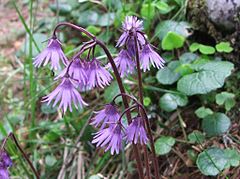Soldanella
| Soldanella subsp. var. | ||||||||||||||||||||||||||||||||||||||||||||||||||||||||
|---|---|---|---|---|---|---|---|---|---|---|---|---|---|---|---|---|---|---|---|---|---|---|---|---|---|---|---|---|---|---|---|---|---|---|---|---|---|---|---|---|---|---|---|---|---|---|---|---|---|---|---|---|---|---|---|---|

|
|
| ||||||||||||||||||||||||||||||||||||||||||||||||||||||
| ||||||||||||||||||||||||||||||||||||||||||||||||||||||||
The genus Soldanella, commonly known in English as snowbell, includes about 15 species in the flowering plant family Primulaceae, native to European mountains, from the Pyrenees, the Apennines, the Alps, the Carpathians and the Balkans. They grow in woods, damp pastures and rocky landscapes from 500-3,000 m above sea level, usually in hollows which hold snow long into the summer.
They typically have a basal rosette of simple, orbicular leaves 1–5 cm wide, with the flower stalks arising from the centre of the rosette, each stalk bearing 1-6 white to violet flowers.
| Standard Cyclopedia of Horticulture |
|---|
|
Soldanella (Latin, a small coin, referring to the shape of the leaves). Primulaceae. Small glabrous perennial herbs with short rhizomes, hardy and useful in the border or rock-garden. Leaves long-petioled, thick, cordate-orbicular or reniform, entire: scapes slender, solitary or few, 1-fld. or many-fld., umbellate: fls. blue, violet, or rose, rarely white, nodding, about 1/2 – 3/4 in. across: calyx 5-parted, segms. lanceolate, persistent; corolla hypogynous, funnelform-campanulate, 5-lobed to the middle, the lobes laciniate-lacerate; ovary superior, ovoid: caps. conic-oblong, many-seeded.—Species, 6, mountains of Eu. For account of species and cult., see Gn. 61, pp. 126,127; for monograph, Paxt. & Knuth in Das Pflanzenreich, hft. 22 (IV. 237). Soldanellas are amongst the most famous flowers of the Alps, though not the commonest. S. alpina ascends the mountains to the line of perpetual snow. Grant Allen, in "Flashlights on Nature," declares that the flower of soldanella actually thaws its way up through a solid block of ice. Soldanellas are cultivated in this country only in a few rock-gardens. Those who have limited resources and dwell in the region of changeable winters might attempt to grow these plants in pots under a frame in lieu of nature's winter covering. They are said to prefer a half-shady or shady position and are propagated by seed or division. CH
|
Cultivation
Propagation
Pests and diseases
Species
The species are similar to each other and it is nearly impossible to identify images. Subtle differences are observable using a magnifying glass.
The species can be lumped in groups of similar appearance.
Large-sized plants
1. S. villosa occurring in Basque Lands at low elevations has large papery leaves and about 1 mm glandular hairs on petioles.
Medium-sized plants
2. S. alpina including S. occidentalis and S. pyrolaefolia occurring in the Alps and Southern European mountains has sitting glands on petioles, scapes and pedicels.
3. S. carpatica occurring in the Western Carpathians in Slovakia and Poland has sitting glands on petioles but short glandular hairs on pedicels.
4. S. marmarossiensis including S. rugosa occurring in the North-Eastern Carpatians in the Ukraine and Romania has short glandular hairs on petioles and pedicels and narrowly crateriform corolla.
5. S. angusta, S. calabrella, S. chrysosticta including S. cyanaster, S. hungarica, S. major, S. montana, S. oreodoxa, S. pindicola including S. dimoniei and S. macedonica, S. pseudomontana, S. rhodopaea, S. tatricola all having broadly crateriform corolla mutually differ in the length and shape of cells forming short glandular hairs on petioles and pedicells.
Small-sized plants
6. S. alpicola occurring in the Alps, S. pusilla occurring in the Southern Carpathians and S. pirinica occurring in Bulgaria are characterized by the top position of the bract and sitting glands. Often encountered hybrid S. alpina × S. alpicola has laterally positioned bract.
7. S. austriaca and S. minima occurring in the Alps and Apennines are characterized by short glandular hairs and laterally positioned bract.
Soldanella alpicola
Soldanella alpina
Soldanella angusta
Soldanella austriaca
Soldanella calabrella
Soldanella carpatica
Soldanella chrysosticta subsp. chrysosticta
Soldanella chrysosticta subsp. pelia
Soldanella cyanaster = S. chrysosticta
Soldanella dimoniei = S. pindicola
Soldanella hungarica
Soldanella macedonica = S. pindicola
Soldanella major
Soldanella marmarossiensis
Soldanella minima subsp. minima
Soldanella minima subsp. samnitica
Soldanella montana subsp. montana
Soldanella montana subsp. gubalowkae
Soldanella occidentalis = S. alpina
Soldanella oreodoxa
Soldanella pindicola subsp. pindicola
Soldanella pindicola subsp. pelia
Soldanella pseudomontana
Soldanella pusilla
Soldanella pyrolaefolia = S. alpina
Soldanella rhodopaea
Soldanella rugosa = S. marmarossiensis
Soldanella tatricola
Soldanella villosa
Gallery
References
External links
- w:Soldanella. Some of the material on this page may be from Wikipedia, under the Creative Commons license.
- Soldanella QR Code (Size 50, 100, 200, 500)
